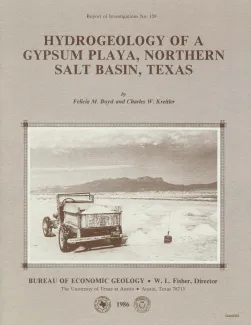
Publication Details
Geolocation:
Get the Publication
$4.50
Abstract/Description:
The northern Salt Basin in West Texas and New Mexico is a closed hydrologic system in which discharge of ground-water flow occurs in a series of playas, or salt flats. Ground water originating in peripheral consolidated rocks and alluvial fans flows toward the center of the basin and discharges by evaporation from the salt flats. Progressive increases in salinity are characteristic of the waters moving down gradient and are primarily attributed to evaporative concentration. Steady increases in sodium (Na+) and chloride (Cl-) and, to a lesser degree, magnesium (Mg+2) and potassium (K+) characterize increases in total dissolved solids (TDS). Intense evaporation above the water table in the salt flats concentrates the composition of brine to TDS values that range from 50,000 mg/L to greater than 300,000 mg/L. Precipitation of minerals from solution, primarily alkaline earth carbonates and gypsum, results in depletion of calcium (Ca+2) and bicarbonate (HCO3-) and relative enrichment of sulfate (SO4-2) in the ground water. Inflowing ground water of a Ca-Mg-SO4 composition undergoes evaporation and evolves to a final composition of a Na-Mg- SO4-Cl brine in the salt flats. Gypsum currently precipitates in the salt flats at a depositional rate that ranges from 0.02 to 0.09 cm/yr. These deposits do not likely represent relict lakebed sediments.Evaporative concentration and mineral precipitation are the most important processes in the basin and flats that affect the composition of the shallow subsurface fluids. However, the chemistry of the brines in the salt flats is occasionally modified by surface water that ponds on the playa surface and percolates downward.